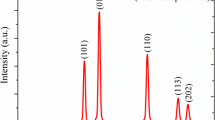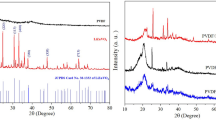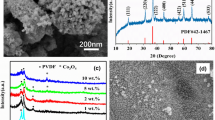Abstract
Flexible material with high dielectric constant and low dielectric losses is extensively used in various areas of electronic industry. In this paper, we synthesize PVDF composite films modified with NiO to get efficient dielectric properties. Dielectric properties such as dielectric constant, dielectric loss, and AC conductivity have been measured over a wide range of frequencies (20 Hz–20 MHz) and temperature (50 °C–150°C). The composite films show the maximum dielectric constant of 100 at 20 Hz for 7 wt% of NiO as compared to pure PVDF. This is due to the improved interfacial polarization at the interfaces between NiO and PVDF matrix. Modified composite films shows increase in AC conductivity with temperature at higher frequencies which can be due to the migration of charge carriers. The increase in AC conductivity is more than three orders of magnitude. The activation energy calculated from AC conductivity analysis varies from 2.93 to 0.85 at the frequency of 100 Hz. Current–voltage (I–V) measurements at different electric field over temperature ranges 50 °C–150°C have been used to explore the charge transport mechanism which is governed by various conduction processes like Ionic hopping, Richardson–Schottky (RS), and Poole–Frenkel (PF) model. However, the analyses suggest that the Schottky conduction mechanism is observed to be responsible for conduction in the modified PVDF films. Modified composite films with high dielectric constant and enhanced conductivity possess the broad application prospects in energy harvesting and sensing devices.








Similar content being viewed by others
References
D.S. Rana, D.K. Chaturvedi, J.K. Quamara, XRD and SEM investigation of swift heavy ion-irradiated polyvinylidene fluoride thin films. J. Mater. Eng. Perform. 20, 276–282 (2011)
A. Gaur, D.S. Rana, Effect of CoCl2–BaCl2 fillers on morphology, dielectric constant and conductivity of PVDF composite for pressure sensing application. J. Mater. Sci. 27, 2293–2299 (2016)
K. Pramod, R.B. Gangineni, Low voltage bipolar resistive switching in self-assembled PVDF nanodot network in capacitor like structures on Au/Cr/Si with Hg as a top electrode. Org. Electron. 42, 47–51 (2017)
K. Parida, V. Bhavanasi, V. Kumar, J. Wang, P.S. Lee, Fast charging self-powered electric double layer capacitor. J. Power Sources 342, 70–78 (2017)
K.Y. Shin, J.S. Lee, J. Jang, Highly sensitive, wearable and wireless pressure sesor using free standing ZnO nano needle /PVDF hybrid thin film for heart rate monitoring. J. Nano Energy 22, 95–104 (2016)
M.M. Abolhasani, K. Shirvanimoghaddam, M. Naebe, PVDF/graphene composite nanofibers with enhanced piezoelectric performance for development of robust nanogenerators. Compos. Sci. Technol. 138, 49–56 (2017)
A. Gaur, D.S. Rana, Structural, optical and electrical properties of MgCl2 doped polyvinylidene fluoride (PVDF) composites. J. Mater. Sci. 26, 1246–1251 (2015)
D.S. Rana, D. Chaturvedi, J. Quamara, Fourier transform infrared and ultraviolet-visible investigation of swift heavy 100 MeV Ag-ion-and 75 MeV oxygen-ion-irradiated polyvinylidene fluoride thin films. J. Eng. Tribol. 224, 667–675 (2010)
D.S. Rana, D. Chaturvedi, J. Quamara, Morphology, crystalline structure, and chemical properties of 100 MeV Ag-ion beam irradiated polyvinylidene fluoride (PVDF) thin film. J. Optoelectron. Adv. Mater. 11, 705–712 (2009)
A.N. Arshad, M. Wahid, M. Rusop, W.H.A. Majid, R. Subban, M. Rozana, Dielectric and structural properties of Poly(vinylidene flouride) (PVDF) and Poly(vinylidene flouride-trifluoroethylene) (PVDF-TrFE) filled with magnesium oxide nanifillers. J. Nanomater. 2019(1–12), 5961563 (2019)
S. Uemura, Low frequency dielectric behaviour of polyvinylidene flouride. Journal of polymer science 12(16), 1177–1188 (1974)
P. Parrini, Electrical conductivity in poly(vinyl chloride). Polymer 14, 445–450 (1973)
K. Hayashi, U. Kubo, Pyroelctricity and space charge in polyvinylidene fluoride. Jpn. J. Appl. Phys. 21, 1379 (1982)
D.S. Rana, Electrical conduction investigation of pristine and swift heavy ion-irradiated polyvinylidene fluoride. Thin Film Int. J. Mater. Sci. Eng. 4, 94–103 (2016). https://doi.org/10.17706/ijmse.2016.4.2.94-103
W.E. Mahmoud, E.H. Mossalamy, H.M. Arafa, Improvement of the mechanical and electrical properties of waste rubber with carbon nanotubes. J. Appl. PolyM. Sci. 121, 502–507 (2010)
R.A.C. Amoresi, A.A. Felix, E.R. Botero, N.L.C. Domingues, E.A. Falcao, M.A. Zaghete, A.W. Rinaldi, Crystallinity, morphology and high dielectric permittivity of NiO nanosheets filling poly(vinylidene flouride). Ceram. Int. 41, 14733–14739 (2015)
W. Guo, K.N. Hui, K.S. Hui, High conductivity nickel oxide thin films by a facile sol–gel method. Mater. Lett. 92, 291–295 (2013)
V. Pulimi, P. Jeevanandam, The effect of anion on the magnetic properties of nanocrystalline NiO synthesized by homogeneous precipitation. J. Magn. Magn. Mater. 321, 2556–2562 (2009)
V.R. Reddy, Electrical properties of Au/polyvinylidene fluoride/n-InP Schottky diode with polymer interlayer. Thin Solid Films 556, 300–306 (2014)
D.S. Rana, D.K. Chaturvedi, J. Quamara, Dielectric constant/loss measurement in 75 MeV oxygen-ion irradiated poly (vinylidene fluoride) films. Optoelectron. Adv. Mater. Rapid Commun. 3, 1354–1358 (2009)
G. Kaur, D.S. Rana, Fabrication and comprehensive investigation on structural, morphological and electrical properties of polyvinylidene fluoride–nickel oxide nanocomposite thin films. J. Mater. Sci. 30, 18153–18158 (2019)
A. Gaur, D.S. Rana, In situ measurement of dielectric permittivity and electrical conductivity of CoCl2/BaCl2 doped PVDF composite at elevated temperature. J. Inorg. Organometall. Polym. Mater. 29, 1637–1644 (2019)
J. Chang, Y. Shen, X. Chu, Large d33 and enhanced ferroelectric/dielectric properties of poly (vinylidene fluoride)-based composites filled with Pb (Zr0.52 Ti0.48) O3 nanofibers. RSC Adv. 5, 51302–51307 (2015)
G.M. Tsangaris, G.C. Psarras, N. Kouloumbi, Electric modulus and interfacial polarization in composite polymeric systems. J. Mater. Sci. 33, 2027–2037 (1998)
A.C. Lopes, C.M. Costa, R. Sabater I Serra, I.C. Neves, J.L. Gomez Ribelles, S. Lanceros-Méndez, Dielectric relaxation, ac conductivity and electric modulus in poly(vinylidene fluoride)/NaY zeolite composites. Solid State Ionics 235, 42–50 (2013)
H. Tang, Z. Zhou, H.A. Sodano, Relationship between BaTiO3 Nanowire aspect ratio and the dielectric permittivity of nanocomposites. ACS Appl. Mater. Interfaces 6, 5450–5455 (2014)
M.A. Rahman, B.C. Lee, D.T. Phan, G.W. Chung, Fabrication and characterization of highly flexible energy harvesters using PVDF-graphene nanocomposites. Smart Mater. Struct. 22(1–10), 085017 (2013)
S. Liu, S. Xue, W. Zhang, J. Zhai, Enhanced dielectric and energy storage density induced by surface-modified BaTiO3 nanofibers in poly(vinylidene fluoride) nanocomposites. Ceram. Int. 40, 15633–15640 (2014)
P. Fan, L. Wang, J. Yang, F. Chen, M. Zhong, Graphene/poly(vinylidene fluoride) composites with high dielectric constant and low percolation threshold. Nanotechnology 23, 365702 (2012)
T.M.W.J. Bandara, D.G.N. Karunathilaka, J.L. Ratnasekera, L.A.D. Silva, A.C. Herath, B.E. Mellander, Electrical and complex dielectric behavior of composite polymer electrolyte based on PEO, alumina and tetrapropylammonium iodide. Ionics 23, 1711–1719 (2017)
D.S. Rana, D.K. Chaturvedi, J.K. Quamara, TSDC measurements and analysis of pristine and 100 MeV Ag-swift heavy ion irradiated polyvinylidene fluoride (PVDF) thin film. J. Optoelectron. Adv. Mater. 6, 642–647 (2012)
H. Ali, U. Khan, M.A. Raliq, A. Falak, A. Narain, T. Jing, X. Xu, Richardson-Schottky transport mechanism in ZNS nanoparticles. AIP Adv. 6(1–8), 055306 (2016)
K. Hayat, M. Rafiq, Rahman, A. Khan, M. Hasan, Size-manipulation, compaction and electrical properties of barium manganite nanorods synthesized via the CHM method. Prog. Nat. Sci. Mater. Int. 23, 388–394 (2013)
Z. Imran, M. Rafiq, M. Hasan, Charge carrier transport mechanisms in perovskite CdTiO3 fibers. AIP Adv. 4(1–13), 067137 (2014)
W. Shirbeeny, M. Hafez, W.E. Mahmoud, Synthesis and characterization of PVA/YBCO nanocomposite for improvement of solar energy conversion. Polym. Compos. 34(4), 587–591 (2013)
G. Sawa, S. Nakamura, K. Iida, M. Ieda, ElectricaL conduction of polypyromellitimide films at temperatures of 120–180 °C. Jpn. J. Appl. Phys. 19, 453–458 (1980)
Acknowledgements
This research was supported by UGC-DAE Consortium for Scientific Research, University Grants Commission (Grant No. NFO-2018-19-OBC-HAR-73864).
Author information
Authors and Affiliations
Corresponding author
Additional information
Publisher's Note
Springer Nature remains neutral with regard to jurisdictional claims in published maps and institutional affiliations.
Rights and permissions
About this article
Cite this article
Kaur, G., Rana, D.S. Dielectric spectroscopic investigations and electrical conduction mechanism of PVDF–NiO nanocomposite thin films. J Mater Sci: Mater Electron 32, 4713–4726 (2021). https://doi.org/10.1007/s10854-020-05209-2
Received:
Accepted:
Published:
Issue Date:
DOI: https://doi.org/10.1007/s10854-020-05209-2




